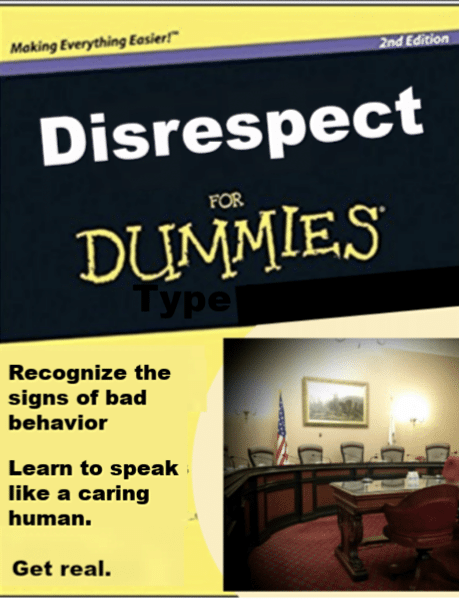[et_pb_section bb_built=”1″ _builder_version=”3.0.47″][et_pb_row _builder_version=”3.0.47″ background_size=”initial” background_position=”top_left” background_repeat=”repeat”][et_pb_column type=”4_4″][et_pb_text _builder_version=”3.0.106″ background_size=”initial” background_position=”top_left” background_repeat=”repeat” background_layout=”light”]

Enough!! I hate to add anything to the pantheon of required government trainings, but I figured a little handbook was urgently needed at congressional hearings, so I created something you can keep in front of you at committee meetings, hearings, or public events where you want to look like a decent human being. I call it Disrespect for Dummies. Who’d have thought it would be needed? I’ve kept the list short and basic. (I’m also working on a poster for those who don’t read books.) The reading level is simple–about the level of a US Senator, member of Congress, or third grader. Because this is a draft, I welcome your suggestions. This way you can feel you have accomplished something positive after watching government hearings. Instead of just rushing to wash your hands.
Here are the fifteen signs of disrespect:
- Not making eye contact when someone asks to speak with you directly.
- Interrupting before someone has even begun to make her or his point.
- Refusing to listen to an idea that is relevant to the conversation.
- Talking at someone rather than talking to them.
- Talking about someone like she (or he) is an “it.” This includes talking about a person in their presence or behind their backs.
- Using a colleague’s point as your own in a meeting, without crediting the idea. (Particularly noxious after ignoring an idea that came originally from the opposite sex,) This can also be called “stealing.”
- Tweeting while someone is talking to you.
- Sneering or sarcasm.
- Making derogatory comments or off-handed remarks about someone during a meeting, often to an associate.
- Not responding in a compassionate way to someone else’s heartfelt emotion.
- Making sexual references to a person in public.
- Generalizing about a person because of their affiliation, such as race, gender, nation, or political party.
- Closing a meeting abruptly and arbitrarily while group members are waiting to be heard.
- Announcing your decision prior to hearing evidence.
- Hoarding information or evidence so that your associates won’t know what you’re talking about; bogarting.
That’s my starter series. Yours?
If I had room on the poster (I won’t), I’d add three more:
- Passing laws that will directly affect a group of people without including them in the decision-making process in more than a peripheral way.
- Not passing laws that are needed to protect a group of people because you didn’t, well, notice that they were needed.
- Assuming someone is guilty because of the color of their skin or the sound of their last name.
I’ve kept this simple, out of respect for very short attention spans. I admit to a few paradoxes. One is that I’m being rather disrespectful of our national disrespecters, including the disrespecter-in-chief. Oh dear. It seems the disease is catching. In a rare tip of the hat to non-partisanism, these tips apply across sectors, and to all sides of the House. Even to pundits and commentators. I admit that the idea of requiring people to read a Dummy’s Guide might seem disrespectful, but that’s another story,
Tell me what you see…and then, even better, what to do about it.
[/et_pb_text][/et_pb_column][/et_pb_row][/et_pb_section]










3 Responses
Beautiful! Here! Here!
Thank you for this.
I would add:
Treating someone a if they are inferior to you.
Demanding instead of asking.
Refusing to use a persons name when you know it.
Great additions!